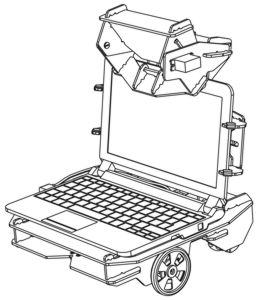INTRODUCING OCULUS
The Oculus system converts a small, reasonably modern, standard clamshell style laptop computer into a telerobotic, remotely operated vehicle. It uses the laptop cpu to run the control software, the laptop’s battery to power the motors, the laptop’s webcam and microphone for sensory input, and a wifi network for untethered communication. The adjustable frame fits best with 11" laptops or smaller.
The frame has powered wheels, and a tilting periscope aligned with the laptop’s built-in webcam. Control software runs on Windows XP/Vista/7 and Linux, and is simple to install and configure. (The only potentially tricky part, for some, will be forwarding the 2 required ports thru your wifi network router, so the bot can be accessed over the internet.) Power and communication to the motors and controller is supplied entirely via the laptop’s USB port. When not in use, the system is charged using the laptop’s stock charger, routed through the included charging dock.

Once setup and running, you can log-in to your Oculus from any PC connected to the internet, from anywhere in the world, using just a web-browser. Usually no extra software install is required (the browser must have the adobe flash 10 or higher plugin, which is already installed in over 98% of the worlds PCs, according to Adobe). Remote (client) PCs can be running Windows, OS X, Linux or other operating systems, so long as they have a reasonably modern browser with the Flash 10 plugin. Android and iOS handheld client apps are also available.
After you’ve logged in, you can stream real-time video (captured from the Oculus laptop’s built-in-webcam), and audio (captured from the built-in microphone). And of course, you can drive around. You’ll have surprisingly precise and responsive steering control, and you can look up and down by tilting the upper mirror of Oculus’s periscope.
If you have a webcam on the PC you’re connecting from you can also broadcast your own image and voice onto the screen and through the speakers of your Oculus laptop, for a true telepresence/video chat experience. Also, you can add multiple accounts so you can have many people connected to Oculus at once: one driver, and one or more passengers along for the ride, all seeing the same video stream.
The control software is free and open source, and easily extensible for hackers/enthusiasts who want to add their own robotic functionality. Also, the software will work just fine if installed on a desktop or laptop Windows PC without the Oculus hardware present: you won’t be able to drive around (obviously), but you’ll be able to broadcast audio and video to remote browsers as long as your machine has a webcam and mic.
